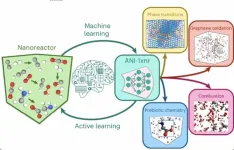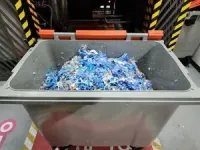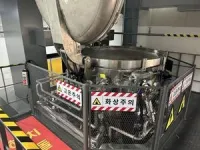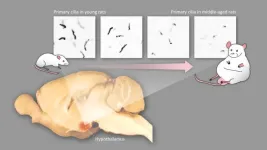(Press-News.org) DALLAS (SMU) – What exactly happens at the tiny scale at which individual atoms exist and interact? SMU chemist Elfi Kraka and her colleagues have been working on developing a computational tool aimed at providing answers to that mystery.
Mathematical functions used to calculate the potential energy of a system of atoms are called interatomic potentials. Machine learning interatomic potentials (MLIP)s have become an efficient and less expensive alternative to traditional quantum chemical simulations, which even on today’s high-performance computing often become out of reach for larger systems. In their quest, the researchers developed a novel MLIP, called ANI-1xnr that is applicable to a broad range of reactive chemistry without the need for costly refitting, a major drawback of the MLIPs currently in use. Their findings appear in the journal Nature Chemistry.
“Understanding interactions at the atomic level could aid us in caring for our planet, impact the ways drugs interact with the human body, and even let us explore organic materials that have come to Earth thanks to comets and asteroids or simulate chemical reactions taking place far out in space including star dusts or interstellar grains,” Kraka said.
Kraka and her colleagues put their new ANI-1xnr potential to the test, simulating five distinct systems in extreme environments: carbon solid-phase nucleation, graphene ring formation from acetylene, biofuel additives, combustion of methane and the spontaneous formation of glycine from early earth small molecules (the famous Miller experiment), with all five closely matching available experimental or theoretical data.
Miller conducted an experiment in 1959, applying electricity to a mixture of simple molecules, such as ammonia, carbon monoxide, water, hydrogen, and methane uncovering how amino acids, important life-building blocks, were formed. His experiment created a new field of study called prebiotic chemistry, which aims to understand the chemical processes and reactions that occurred on Earth before the emergence of life. Since then, scientists have referred to Miller's experiment to understand specific reactions that lead to the formation of amino acids under Early Earth conditions.
The ANI-1xnr dataset is now available publicly for research use. The authors intend expand and further train ANI-1xnr over time, where Kraka is particularly interested in exploring the formation of amino acids and precursors of DNA from small molecules under extraterrestrial conditions, one of her recent research interests.
Kraka is head of the Computational And Theoretical Chemistry Group (CATCO) at SMU. CATCO’s research mission is to develop modern quantum chemical tools and to apply these tools to solve pending problems in chemistry, biology, materials science, astrophysics, and beyond. CATCO is one of the high-volume user groups of SMU’s high performance computing cluster. Malgorzata Makos, another paper author, is a CATCO graduate who interned at the Los Alamos National Laboratory and now works Oak Ridge National Laboratory in Tennessee.
Additional authors include: Shuhao Zhang, Carnegie Mellon University and Los Alamos National Laboratory; Ryan Jadrich, Kipton Barros, Benjamin T. Nebgen, Sergei Tretiak, Nicholas Lubbers and Richard Messerly from Los Alamos National Laboratory; Olexandr Isayev from Carnegie Mellon University and Justin Smith from Los Alamos National Laboratory and NVIDIA Corp.
Funding for the study’s CATCO component was provided by the National Science Foundation, grant CHE 2102461. Any opinions, findings, and conclusions or recommendations expressed in this material are those of the authors and do not necessarily reflect the views of the National Science Foundation.
###
SMU is the nationally ranked global research university in the dynamic city of Dallas. SMU’s alumni, faculty and more than 12,000 students in eight degree-granting schools demonstrate an entrepreneurial spirit as they lead change in their professions, communities and the world.
END
Although women have breastfed since the beginning of time, there is very little scientific research on how exercise affects breast milk.
Online forums for pregnant women and new mothers are full of questions about this exact issue:
Can exercise cause breast milk to go sour? What happens to breast milk if you do high-intensity interval training? Will strenuous exercise affect your milk supply?
“There are so many myths about exercise and breast milk. We simply need more knowledge,” says researcher Trine Moholdt at the Norwegian University of Science and Technology (NTNU).
She heads several international research projects ...
The ACMG Foundation for Genetic and Genomic Medicine is proud to present the ACMG Foundation/David L. Rimoin Inspiring Excellence Award to Christiana Wang, BS for her featured platform presentation at the 2024 ACMG Annual Clinical Genetics Meeting, “Antisense oligonucleotide targeting a linked-SNP provides allele-specific and effective knockdown to a dominant negative SPTAN1 pathogenic variant.”
Christiana Wang, BS, is a second-year PhD candidate in the Department of Molecular ...
ATLANTA – New data provided by studying the beluga whales at Georgia Aquarium helps close a key information gap about how much food these whales need to thrive. The information will inform important management decisions for their counterparts in Alaska’s Cook Inlet, which are protected under the U.S. Endangered Species Act (ESA).
A new study released in the Journal of Experimental Biology, led by Terrie M. Williams, Director of the Integrative Carnivore EcoPhysiology Lab, with her graduate student Jason John at the University of California-Santa Cruz in partnership ...
Americans already living in housing supported by federal housing assistance programs have significantly lower blood lead levels than counterparts who would later join these programs, according to new research led by environmental health scientists at Columbia University Mailman School of Public Health and Tufts Medical Center. The findings appear in the peer-reviewed journal Environmental Health Perspectives.
“Living in federally-supported housing—especially public housing—limited opportunities for residents’ exposure to lead,” says first author MyDzung Chu, Ph.D., assistant professor in the Institute for ...
Residential heating by coal has for decades been the major contributor to the high levels of air pollution in Krakow, Poland. New research finds a nearly 40 percent decline in the annual average concentration of respirable particulate matter (PM2.5) in Kraków, Poland, between 2010 and 2019 following the implementation of policies targeting emissions from the burning of coal and other solid fuels. Researchers show the improvement in air quality translated to substantial benefits for children’s outcomes, including fewer cases of asthma and better birth outcomes.
The ...
Nagoya University researchers and their colleagues in Japan have found that middle-age obesity is caused by age-related changes in the shape of neurons in the hypothalamus, a region of the brain that controls metabolism and appetite.
A protein called melanocortin-4 receptor (MC4R) detects overnutrition and regulates metabolism and appetite to prevent obesity. According to their study in rats, MC4Rs were concentrated in primary cilia (antenna-like structures) that extend from a couple of groups of hypothalamic neurons. The study also showed that the primary cilia became shorter with age, which decreased MC4Rs accordingly, ...
Recently, Nano Research announced awardees of the 2023 Nano Research Young Innovators (NR45) Awards in Bio-inspired Nanomaterials. Thirty-three outstanding young investigators under the age of 45 were selected for their extraordinary contributions in developing bio-inspired nanomaterials with applications spanning clean energy, human healthcare, monitoring, and disease treatments. They were selected through a competitive process by an award committee from Nano Research’s editorial board. Congratulations to all the 33 awardees in 2023!
The NR45 Awards ...
A medical waste treatment system, which is capable of 99.9999 percent sterilization by using high-temperature and high-pressure steam, has been developed for the first time in the country.
The Korea Institute of Machinery and Materials (President Seog-Hyeon Ryu, hereinafter referred to as KIMM), an institute under the jurisdiction of the Ministry of Science and ICT, has succeeded in developing an on-site-disposal type medical waste sterilization system that can help to resolve the problem caused by medical waste, which has become a national and social issue as the volume of medical waste continues ...
A research team, affiliated with UNIST, has unveiled for the first time a new principle of motion in the microworld, where objects can move in a directed manner simply by changing their sizes periodically within a substance known as liquid crystal. Led by Professor Jonwoo Jeong and his research team in the Department of Physics at UNIST, this discovery is poised to have far-reaching implications across various research fields, including the potential development of miniature robots in the future.
In their research, the team observed that air bubbles within ...
A four-year study by Dartmouth researchers captures the most in-depth data yet on how college students' self-esteem and mental health fluctuates during their four years in academia, identifying key populations and stressors that the researchers say administrators could target to improve student well-being.
The study also provides among the first real-time accounts of how the coronavirus pandemic affected students' behavior and mental health. The stress and uncertainty of COVID-19 resulted in long-lasting behavioral changes that persisted as a "new normal" even as the pandemic diminished, including feeling more stressed, less socially engaged, and sleeping more.
The ...






